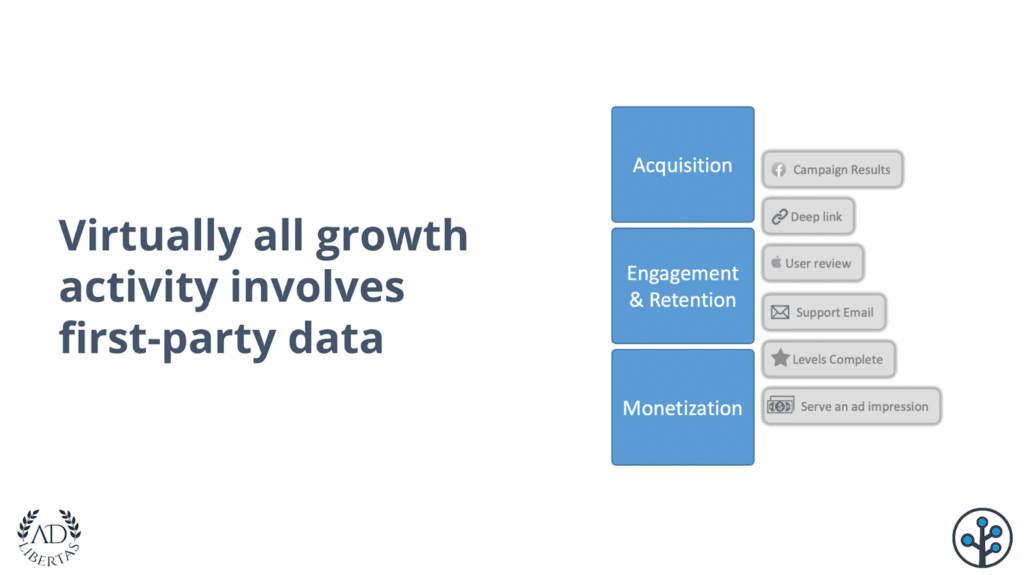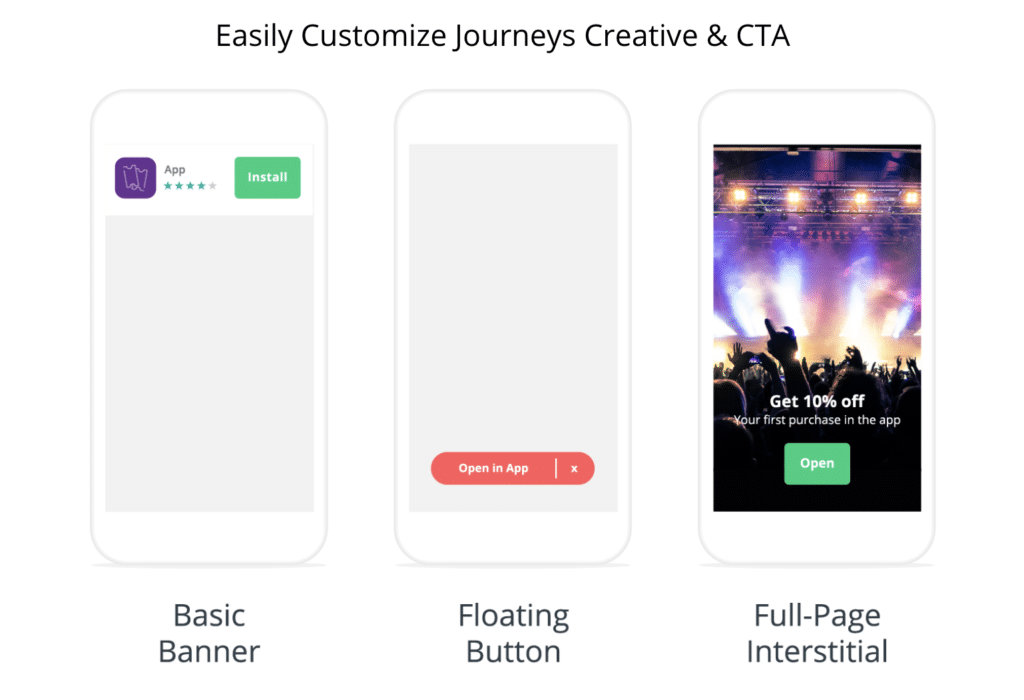As data sharing practices become more stringent and the focus on privacy increases, mobile app marketers are shifting away from third-party data and looking for more reliable, accurate alternatives. One such alternative that has been getting a lot of attention recently: first-party data.
The term “first-party data” can get a bad rap, and often for good reasons. Some uses of first-party data can seem undesirable to consumers, or even downright creepy.
But it doesn’t have to be this way. Truth is, as long as first-party data is well-protected and stays within an organization, it’s mainly used to serve better, more relevant, and personalized experiences to users.
To help you understand how brands are using first-party data to drive mobile growth, we will cover:
- How experts are leveraging first-party data to drive growth
- What you should expect about first-party data in the coming years
- How to make the most out of your first-party data
What is first-party data?
First-party data is defined as any information you collect directly from your customer, the end-user. This includes mobile app interactions, ad impressions, purchase history, behavior, preferences, geography, install information, and anything that mobile app owners can collect to provide more personalized, relevant experiences.

Done right, leveraging first-party data can truly help you unlock opportunities across marketing and product. From A/B testing to deep linking, crash reporting to the measurement of owned and organic marketing channels, first-party data is the key to understanding your app’s best features and optimizing them for better growth. The key lies in how you collect and manage first-party data.
In our recent webinar, How apps are using first-party data to drive growth, we asked experts across the mobile industry to share their insights and hot takes on the opportunities and risks associated with first-party data. Most importantly, we asked how they are planning to leverage first-party data in the coming year.

How are experts leveraging first-party data to drive growth?
Collect the right data
It all starts with the right data collection. You need to know the specific data points you need to support your audiences and campaigns. You’ll also need to know how you plan to collect these data points. When tracking user actions (like user onboarding), it is especially helpful to measure interactions and track behavior early on. This will allow you to see how users are interacting with the app, where they are engaging the most, and where they are dropping off.
Being able to find a signal to map your user acquisition early on, let’s say within the first 24-hour attribution window, can help you determine the performance of your campaigns. Moreover, tying these early signals to a longer-term revenue per user (RPU) curve based on a genre can bring you closer to optimizing your next steps.
For example, in gaming apps, user acquisition is a critical component in determining a game’s success. Information about install events, campaign performance, and upfront cost is vital to collect. With this knowledge, gaming app owners can better understand how to drive higher user acquisition.
So whether it’s an SDK ad network or trying to get an early signal, gaming apps can route players toward specific types of actions in the game. This can help app owners derive more information about campaign results.
Use a single source of truth
Chances are your customers’ first-party data is stored in fragmented silos of your third-party technology vendor platforms. Bringing all this data together in a single place, tracking insights, and managing your business can be daunting. One of the best ways to manage your first-party data is having a single source of truth like a CRM (customer relationship management) system that helps you collect, analyze, and manage data in a single dashboard.
Many of Branch’s savvy customers use first-party data to complement their Branch data exports. This helps them make better data-driven decisions and increases cross-functional team collaboration.
Test and reiterate to determine success
One of the impacts of IDFA deprecation from a monetization perspective is that mobile developers and marketers are no longer able to target high-value optimized users. This, in turn, impacts monetization and has resulted in declining mobile app downloads and user engagement.
To counter this, marketers can leverage first-party data to define user segments and parameters. This will dynamically push content and campaigns that have a higher chance of success. In simple terms, your first-party data can show you all the touchpoints in a customer’s journey and their exact behavior. Using this information, you can optimize your mobile apps to be even better. So consider asking questions like, “What is the potential optimal behavior for my app?”
For example, to improve the first-time user experience for a mobile game, you can experiment with your onboarding process. Do this by using interactive elements and offering discounts. Give players an opportunity to connect their social channels. Or run A/B tests to see how users interact with ads by varying parameters like frequency of ads being shown, ad location on the screen, demographics, etc. From here, you can create segments offering players different ads based on these parameters. Once you have your audience buckets ready, you can set the default game behaviors for first-time users and players in different countries. You can also apply the same technique to assess your rewards and loyalty programs.
Future first-party data trends to look out for
The rise of a new wave within data science
While this was sort of overestimated in the past, it’s expected to live up to the hype this time. Mobile app brands will need to hire data scientists for all sorts of sophisticated types of analysis that will emerge in the future. This will be especially true as regulations around data privacy continue to evolve (and make it harder for mobile apps to drive engagement and overall growth). You should be prepared to hire industry experts who can use first-party data to deepen engagement on different channels. This will ultimately strengthen your customer retention and acquisition efforts.
Creating tailored experiences to deliver a delightful user experience
As marketers continue to expand their cross-channel strategy, customer data touchpoints are appearing across multiple platforms more than ever before. To truly unlock the power of first-party data, marketers will need to implement solutions that bridge the gap between different channels: web-to-app, email-to-app, social media-to-app, etc. By integrating personalization throughout these channels, brands can provide customers with the most relevant, frictionless experience. Doing so will potentially increase user engagement, retention, and purchases.
Let’s say, for example, you’re aiming to convert your website traffic into mobile app users. The next step would be to invest in a solution that allows you to seamlessly route users from your website to your app. With Journeys, a Branch solution, brands can create customizable and targeted banners, interstitials, and pop-ups to drive app installs from the web.
Imagine you’re a marketer working for an entertainment app and you want to run a display campaign promoting your latest show. Traditionally, you would only be able to display a static ad to users located in the USA. But with solutions like Journeys, your first-party data strategy could be targeted and very precise. You could run dynamic ads and banners containing personalized messages based on a range of different factors like previous viewer interactions, user behavior, location, clicks, and intent. Using Journeys, you could also deliver tailored content to viewers based on their interactions with the show.

Leverage owned channels to offer compelling value propositions
Customers increasingly want more transparency. They want to know who is collecting their data, how their data is being used and what the benefits are for sharing their information with brands. Protecting customer privacy is a delicate dance. With first-party data, it is easier to continue the delicate dance and still build virtuous cycles that recognize and reward loyalty.
One effective way to do this is to implement a referral program. This encourages your existing users to invite their network to download your mobile app. According to data from Nielsen, 83% of online respondents state they were more likely to buy if a friend referred them. Therefore, a referral program is the most trusted marketing campaign you can employ to drive new users to your app with very low investment.
As you integrate a referral program into your first-party data strategy, an important question to ask is, “Do we have the right tools to measure our referral program’s performance?” Having a backend tool that powers your referral program is key here. You may want to consider using an MLP (mobile linking platform) like Branch. Branch’s MLP provides powerful analytics and insights to help ensure successful performance measurements for referral programs. Furthermore, it offers accurate data matching to ensure your app credits the correct referring user.
EazyDiner, India’s largest restaurant and table booking app, uses Branch’s MLP to build its referral program.

How to make the most out of your first-party data?
When you’re shifting away from a cookie-based marketing strategy, you need to take a proactive approach to data collection. The earlier you start collecting first-party data, the better. You’ll be able to understand and respond to your customers’ needs and intent with higher contextual relevance.
First-party data improves an organization’s ability to quickly interpret and respond to opportunities. This way, brands can deliver a meaningful experience based on accurate data, rather than presumptuous third-party data that occurred months ago. And as your relationship with your customers progresses, you can create segments, refine your data sets, and add new details to make sure your first-party data is fresh and precise!
Understanding how your first-party data fits in your cross-channel marketing strategy is critical. Your strategy must include your marketing and customer experience goals and objectives, as well as a roadmap for how you intend to use your first-party data to achieve those objectives . This will allow you to target content recommendations and personalized advertising at a more granular level.
Finally, when you obtain information from your customers or prospects directly, it ensures that your data is privacy compliant, but also puts you ahead of the competition.
Ready to get started with your first-party data strategy? Learn more about how Branch’s solutions can help you unlock the power of your first-party data.
Branch provides the industry’s leading mobile linking and measurement platforms, offering solutions that unify user experience and attribution across devices and channels. Branch has been selected by over 100,000 apps since 2014 including Adobe, BuzzFeed, Yelp, and many more, improving experiences for more than 3 billion monthly users across the globe. Learn more about Branch or contact sales today.






















